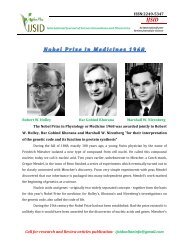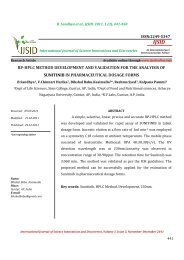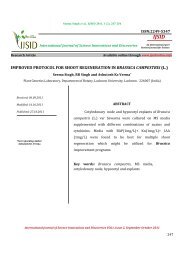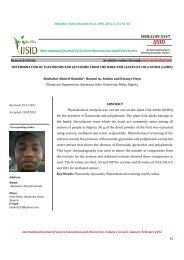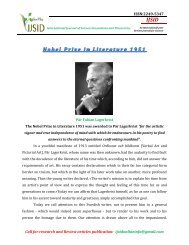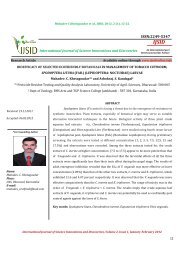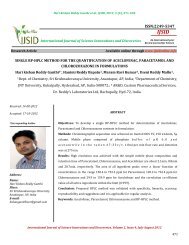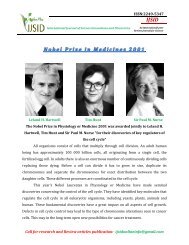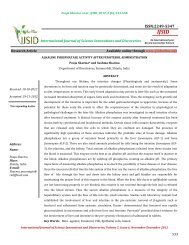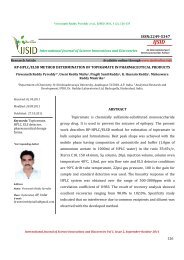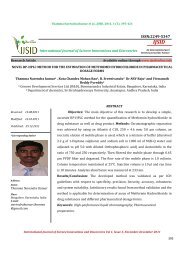URTICA SIMENSIS STEUDEL - Ijsidonline.info
URTICA SIMENSIS STEUDEL - Ijsidonline.info
URTICA SIMENSIS STEUDEL - Ijsidonline.info
Create successful ePaper yourself
Turn your PDF publications into a flip-book with our unique Google optimized e-Paper software.
Eskedar Getachew Assefa et al., IJSID, 2013, 3 (1), 153-160<br />
International Journal of Science Innovations and Discoveries<br />
NUTRITIONAL PROFILE OF SAMMA (<strong>URTICA</strong> <strong>SIMENSIS</strong> <strong>STEUDEL</strong>) LEAVES GROWN IN ETHIOPIA<br />
Eskedar Getachew Assefa 1 , Gulelat Desse Haki 2* Getachew AddisDemoz 3<br />
1 Addis Ababa University, College of Natural Science, Addis Ababa, Ethiopia, 2* Botswana College of Agriculture, Private Bag<br />
0027, Gaborone, Botswana, 3 Ethiopian Health and Nutrition Research Institute, Addis Ababa, Ethiopia<br />
INTRODUCTION<br />
ISSN:2249-5347<br />
IJSID<br />
An International peer<br />
Review Journal for Science<br />
Research Article Available online through www.ijsidonline.<strong>info</strong><br />
Received: 14-01-2013<br />
Accepted: 18-02-2013<br />
*Corresponding Author<br />
Address:<br />
Name:<br />
Gulelat Desse Haki<br />
Place:<br />
Gaborone, Botswana<br />
E-mail:<br />
hgulelat@bca.bw,<br />
gulelatw@yahoo.com<br />
ABSTRACT<br />
The nutritional and antinutritional levels of raw Samma leaves (Urtica Simensis)<br />
grown in Ethiopia were investigated for their proximate composition, ascorbic acid<br />
(vitamin C), antinutrients (condensed tannin and oxalate) and minerals (Fe, Ca, Zn). The<br />
ranges of moisture, crude protein, crude fat, crude fibre and total ash in the leaves<br />
collected from three different areas (Debreberhan, Fitche and Ambo) were found to be<br />
76.8-78.9 %, 25.1-26.3 %, 2.2-2.3 %, 8.5-9.4 % and 20.8-26.4 %, respectively. The ranges<br />
of mineral contents of raw samples (iron, zinc and calcium) were 38.4 -47.0, 2.87-5.8 and<br />
768.6-793.4 mg/100g, respectively and they were found to be rich in vitamin C (82.65 -<br />
84.3%). Tannin ranged from 25.3-27.0 mg/100g while oxalate was 8.59- 9.33 mg/100g.<br />
The study showed that these indigenous leafy vegetable have high nutritive contents and<br />
their consumption need to be promoted in the various regions of Ethiopia.<br />
Key Words: Urtica Simensis, Samma, Ascorbic Acid, Condensed tannin<br />
International Journal of Science Innovations and Discoveries, Volume 3, Issue 1, January-February 2013<br />
153
Eskedar Getachew Assefa et al., IJSID, 2013, 3 (1), 153-160<br />
INTRODUCTION<br />
Wild food plants play a very important role in the lively hoods of communities as an integral part of the subsistence<br />
strategy of people in developing countries (1 ). Locally available wild food plant serves as alternatives to staple food during<br />
periods of food deficit, valuable supplement for nutritionally balanced diet and primarily alternative sources of income for<br />
many resources poor communities. Indigenous vegetables supply the body with minerals, vitamins, fibre, quality protein,<br />
colour, flavour and are recognized for their therapeutic value and certain hormone precursors (2).<br />
Nettle is one of wild plants found all over the temperate areas of the world. It is the common name for 30-45 species<br />
of flowering plants which belongs to the genus Urtica of the family Urticaceae. They are often easily recognizable particularly<br />
after having experienced the sting. It can be found in a variety of habitat and soil type (3).<br />
Samma (Urtica simensis) is one of species of Nettel and endemic in Ethiopia. It is dark green perennial wild plant and<br />
the leaves are used as a food eaten as pot herbs in some areas of Ethiopia (4 ). Ecologically Urtica simensis is found in Upland<br />
grassland areas most common in disturbed localities, often plentiful near houses. It could fill a valuable place in the production<br />
of food in rural areas where the climate is not conducive to the production of vegetables and at a time when cultivated green<br />
leafy vegetables are not ready to use. Although in few areas of Ethiopia,<br />
Urtica simensis (Samma) have traditionally been used for food and as medicinal plants. Its potential contribution to<br />
food security, nutrition, health, and income generation for the well-being of mankind is still largely underexploited. The<br />
potential of spreading its use across regions and cultural groups is, likewise not yet looked in to. In general in Ethiopia, the<br />
potential of wild vegetable species in food and nutrition security, health and in-come generation should be increased in the<br />
face of the growing environmental and socio–economic changes.<br />
An important remedy for food security problems is food items diversification. Urtica simensis (Samma) can assist the<br />
majority of our society, provided the society acknowledges it and produce it in line with the other crops. Surprisingly, no<br />
studies were conducted with regard to its chemical composition and nutritional values in Ethiopia. Thus, this study aims at<br />
investigating the nutritional value, antinutritinal factors and effect of processing on the quality of Urtica simensis locally<br />
known as Samma leaf, which is found in different parts of Ethiopia.<br />
Sampling area<br />
MATERIALS AND METHODS<br />
The leaves of raw Samma (Urtica simensis) were collected from Fitche, Ambo and Debrebrehan, Ethiopia, where its<br />
consumption is high.<br />
Sample preparation<br />
About 2 kg of plant material was collected from each area in the morning and placed in isothermal box with ice packs<br />
and brought to the laboratory for analysis. In the laboratory the edible part of raw Samma leaves were sorted, crushed<br />
between the two hides and rubbed them to avoid the stinging hairs which are responsible for the burning sensation of the<br />
leaves. After that the leaves of the plant materials were thoroughly mixed, the non edible part is removed, washed with tap<br />
water and rinsed with de-ionized water. The residual moisture on the surface of the vegetable was soon dried with blotting<br />
paper. Moisture and Vitamin C contents of the raw Samma leaves were analyzed on the same day of collection. The remaining<br />
sample was dried in an oven maintained at 45 0 C and ground to fine powder using pestle and mortar. The powder was then<br />
sieved through a 2.0 mm wire mesh.<br />
International Journal of Science Innovations and Discoveries, Volume 3, Issue 1, January-February 2013<br />
154
Proximate Analysis<br />
Eskedar Getachew Assefa et al., IJSID, 2013, 3 (1), 153-160<br />
Proximate compositions of the leaves of Samma were determined according to AOAC 2000 (5). The moisture content<br />
was determined by air-oven drying at 110 o C for 1 hr, and the crude protein contents by micro Kjeldahl method (% protein = N<br />
x 6.25). The lipid content was determined using diethyl ether (boiling point, 55 °C) in a soxhlet extraction apparatus and crude<br />
fiber content by dilute acid and alkali hydrolysis. Ash was determined by incineration of known weights of the samples in a<br />
muffle furnace at 550 0 C until a white ash was obtained. Carbohydrate contents were calculated by difference of total contents<br />
from 100.<br />
Determination of Gross Energy<br />
Gross energy was determined by calculation from fat, carbohydrate and protein contents using the Atwater’s<br />
conversion factors; 16.7 kJ/g (4 kcal/) for protein, 37.4 kJ/g (9 kcal/g) for fat and 16.7 kJ/g (4 kcal/g) for carbohydrates and<br />
expressed in calories (6).<br />
Analysis of Ascorbic Acid<br />
Determination of total Ascorbic Acid (Vitamin C) was done spectrophotometrically at wave length of 515nm by<br />
Methods of Vitamin Assay (7).<br />
Mineral Analysis<br />
Up on ashing for the determination of the total ash content 3 drops of 1M HNO3 acid was added to the sample in each<br />
of the crucibles. The ash was digested by using 6N hydrochloric acid. The digested sample was filtered in to sample bottles<br />
each using the Whatmann filter paper (42mm) prior to analysis. The Fe, Zn and Ca, content in the sample was determined<br />
using atomic absorption Spectrophotometer (AAS) of Buck Scientific Atomic absorption Spectrophotometer, 210VGP, 4-555<br />
Wentworth Street East Oshawa, Ontario, L1H 3V8, Canada, at 248.3nm, 213.9nm, 285.2nm, 422.7nm and 279.5nm<br />
Wavelengths respectively using air acetylene flame. The concentration of the elements in the sample was calculated as:<br />
Concentration (mg/100g) =<br />
Where: a, b, concentration in ppm of sample and blank solution, and V, volume in mL of the extract (8).<br />
Condensed Tannin<br />
DETERMINATION OF ANTINUTRIENTS<br />
Tannin content was determined by the method of Burns (9) as modified by Maxson Rooney (10). About 0.1g of Samma<br />
leaves were weighed in a screw cap test tube. The 0.1g dried Samma was extracted with 10 mL of 1% HCl in methanol for 24<br />
hours at room temperature with mechanical shaking. After 24 hours shaking, the solution was centrifuged at 1000 rpm<br />
(revolution per minute) for 5 minutes. A 1ml of supernatant was taken and mixed with 5 ml of vanillin-HCl reagent (prepared<br />
by combining equal volume of 8% concentrated HCl in methanol and 4% Vanillin in methanol).<br />
D-catechin was used as standard for condensed tannin determination. A 40 mg of D-catechin was weighed and<br />
dissolved in 1000 ml of 1% HCl in methanol, which was used as stock solution. A 0, 0.2, 0.4, 0.6, 0.8 and 1 ml of stock solution<br />
was taken in test tube and the volume of each test tube was adjusted to 1ml with 1% HCl in methanol. A 5ml of vanillin-HCl<br />
reagent was added into each test tube. After 20 minutes, the absorbance of sample solutions and the standard solution were<br />
measured at 500nm, and the calibration curve was constructed from the series of standard solution using SPSS-15.<br />
International Journal of Science Innovations and Discoveries, Volume 3, Issue 1, January-February 2013<br />
155
Determination of Oxalate Content<br />
Eskedar Getachew Assefa et al., IJSID, 2013, 3 (1), 153-160<br />
The oxalate content was determined using the method in Manual for Nutrition Surveys (7). The procedure involves three<br />
steps: digestion, oxalate precipitation and permanganate titration.<br />
Data analysis<br />
The analysis was carried out in triplicates for all determinations. The mean and standard deviation of means were<br />
calculated. The data were analyzed by one way analysis of variance (ANOVA) in SPSS 15.0 for windows.<br />
Nutrient Content of Raw Samma Leaves<br />
RESULTS AND DISCUSSIONS<br />
Samma leaves were collected from three areas in Ethiopia (Debreberhan, Fitche and Ambo) to see if there exists<br />
variation in the nutrient composition of the vegetable with respect to geographical location. However, it was found that, except<br />
the mineral and ash content of the leaves, there is no significant difference (P
Eskedar Getachew Assefa et al., IJSID, 2013, 3 (1), 153-160<br />
(11). The relatively higher content of crude fibre in the leaves confirms that low-starchy vegetables are the richest sources of<br />
dietary fibre (15). It is, therefore, suggested that the leaves of the species may be employed in the treatment of diseases s uch<br />
as obesity, diabetes, cancer and gastrointestinal disorders (16). High levels of fibre in foods help in digestion and prevention of<br />
colon cancer.<br />
Ash<br />
Sample from Debreberhan was found to contain relatively higher contents than Fitche and Ambo. The result revealed<br />
that ash content in the studied samples significantly differs (P 0.05) and the values were higher than that reported for<br />
Amaranth and Spinach (17). The significant difference in ash content within the studied samples might be due to variation in<br />
climatic condition, soil type and age of harvested vegetable (18).<br />
Total Carbohydrate<br />
The leaves of Samma exhibited low levels of carbohydrate. A possible explanation is that the species deposits most of<br />
their carbohydrate food reserve in the tuberous root and the leaves are, therefore, consumed for their mineral and other<br />
nutrient contents (19).<br />
Location<br />
Moisture*<br />
(%)<br />
Table 1 Proximate Composition of Raw Samma leaves from Ethiopia<br />
Ash (%)<br />
Crude<br />
protein (%)<br />
Crude fat<br />
International Journal of Science Innovations and Discoveries, Volume 3, Issue 1, January-February 2013<br />
(%)<br />
Crude fiber<br />
(%)<br />
Total CHO<br />
(%)<br />
Energy Kcal<br />
Debrebrhan 78.9±0.8 a 25.4±0.16 a 26.3±0.6 a 2.2±0.5 a 8.5±0.5 a 31.8±0.75 252.2<br />
Fitche 79±1.2 a 25.7±0.8 b 25.6±0.9 a 2.4±0. a 9.4±0.2 a 33.30.30 257.2<br />
Ambo 76.8±0.6 a 26.0±1.7 c 25.1±0.6 2.3±0.1 a 9.1±0.2 a 37.7 ±1.1 271.9<br />
Means not sharing a common superscript letter in a column are significantly different at (P< 0.05). All are edible portion of<br />
* The moisture content is in fresh wet portion per 100 g<br />
Ascorbic acid (Vitamin C)<br />
young shoot of Samma leaves and the values are means of triplicates (± SD).<br />
Ascorbic acid (Vitamin C) concentration (in a wet basis) did not differ statistically in the studied areas (Table 2).<br />
These values were comparable with that of Basella rubra (83.7 mg/100gm) (13) and higher than that of Bonongwe, mo wa<br />
(Amaranthus hybridus) (64%) and Lenghui ( Urtica dioica) (45.3 mg/100gm) (12, 14). Ascorbic acid content of raw Samma<br />
leaves was also higher compared to cultivated green leafy vegetables consumed in Ethiopia spinach ( Spinacea oleracea)<br />
(32.00g/100g), lettuce ( Lactuca sativa) (6.00g/100g) and Swiss chard ( Beta vulgaris) (18.00g/100g) and Kale ( Brassica<br />
carinata) (20.00 mg/100g) (11).<br />
Table 2: Ascorbic acid (Vitamin C) and mineral content of Samma (Urtica simensis) Leaves from Ethiopia<br />
Location<br />
Ascorbic Acid<br />
(mg/100gm)<br />
Fe (mg/100gm)<br />
(DW)<br />
Ca (mg/100gm)<br />
(DW)<br />
(%)<br />
Zn (mg/100gm)<br />
(DW)<br />
Debrebrhan 84.3±1.2 a 42.3±2.47 a 768.6±112 a 4.90±0.73 a<br />
Fitche 86.6 ±1.0 a 38.4±3.68 b 787.7±120 b 2.87±1.09 b<br />
Ambo 82.65±0.9 a 47.0±2.92 c 793.4±132 c 5.8±0.55 c<br />
157
Eskedar Getachew Assefa et al., IJSID, 2013, 3 (1), 153-160<br />
All are edible portion of young shoot of Samma leaves and values are means of triplicates (± SD). Means not sharing a<br />
common superscript letter in a column are significantly different at (P< 0.05<br />
MINERALS<br />
Recovery test<br />
The efficiency of digestion procedure was evaluated using recovery experiment. Result of the analysis is given in Table<br />
3. Looking at the table, the percentage recoveries of Samma sample are between 90.83 % and 106.67 %, which are within the<br />
acceptable range.<br />
Metal Conc. in<br />
sample (mg/g)<br />
Amount<br />
added (mg/g)<br />
Table 3 Recovery Test Results<br />
Conc. in spiked<br />
sample (mg/g) (mean SD)<br />
Ca 7.685 3.0 10.51 0.45 94.17<br />
Fe 0.423 0.4 0.805 0.016 95.67<br />
Zn 0.08 0.08 0.153 0.01 90.83<br />
% Recovery<br />
Results of the studied nutrients of the three samples shows the ability of Samma to accumulate high amounts of both<br />
macro- (Ca) and micronutrient elements (Zn and Fe) (Table 2). With regard to the ranges of concentrations of the studied<br />
metals, it could be arranged according to their levels in the Samma samples of all the sampling sites in the following order in<br />
dry weight basis in mg/100g : Ca(768.6 –793.4) > Fe(38.4 – 47.0) > Zn(2.87-5.8) for Debreberhan, Fitche and Ambo sites,<br />
respectively. The higher level of Ca in the leaves according to Marschner (20) was due to the b road range of Ca-bearing<br />
minerals in soil and water and usually abundant in ground water and surface water which can easily be absorbed by the plant.<br />
Looking at Table 2, it is also clear that the concentration of Ca and Fe were relatively higher followed by Zn in all the samples.<br />
Since most soil types of Ethiopia are moderately acidic to slightly basic with the pH ranges from 5.6 to 7.3 the plant is expected<br />
to have a better accumulation of micronutrients like iron and zinc ( 21). Furthermore, these elements are main elements that<br />
plant could accumulate in their tissue. Therefore, the detection of the high concentration of Zn from trace metals next to iron in<br />
Samma may be because of the fact that these ions are readily transferred from the soil to plants, and accumulate in the leaves<br />
of the plant (18). Thus, Samma could be good alternative source for Zn and Iron.<br />
Results revealed that there is significant difference in metals accumulation within the sampling sites for the three<br />
metals (p< 0.05). The presence of significant difference might be due to the fact that difference in the climatic condition of the<br />
regions and physicochemical property of the soil.<br />
Comparing with other similar vegetables found in Ethiopia and elsewhere, the Fe and Zn content of Samma leaves are<br />
high. The respective amounts of Fe and Zn in Lagose Spinach ( Celosia argentea), Lenghui ( Urtica dioica) and Spinach<br />
(Amaranthus Virids) were 28.3 and 0.2 mg/100gm, 8.9 and 0.15 mg/100gm and 8.8 and 0.25 mg/100gm, respectively. The<br />
range of Fe content of the tested samples is comparable with Bitter Letuce (Launae cornuta ) (44.60 mg/100gm) and African<br />
spider flower ( Gynandropsis gynandra) (47.01 mg/100gm) (22). Thus green leafy wild Samma contains significantly high<br />
concentration of both macro and micronutrients. Hence, Samma, if is included in the daily diet of a person, will have significant<br />
contribution to the RDA (Recommended Daily Allowance) of a person.<br />
International Journal of Science Innovations and Discoveries, Volume 3, Issue 1, January-February 2013<br />
158
ANTINUTRIENT CONTENT OF RAW SAMMA LEAVES<br />
Condensed Tannin<br />
Eskedar Getachew Assefa et al., IJSID, 2013, 3 (1), 153-160<br />
The antinutritional factors are the major factors limiting the wide use of many plants as they are present in the plants<br />
naturally and capable of eliciting deleterious effects in man and animals (23). The results for anti -nutritional factors for<br />
Samma leaves are presented in Table 4. The tannin content of raw Samma leaves collected from Debrebrehan, Fitche and<br />
Ambo areas were 25.3, 28.2 and 27.0 mg/100gm, respectively in dry weight basis. These values were very low compared to<br />
other indigenous wild vegetables reported by Addis (24). In fact this low concentration of condensed tannin is an advantage<br />
for not lowering the bioavailability of other nutrients. There is no significant difference (P
Eskedar Getachew Assefa et al., IJSID, 2013, 3 (1), 153-160<br />
6. Guyot, J.P., Rochette, I. and Treche, S. Effect of fermentation by amylolytic lactic acid bacteria, in process combinations, on<br />
characteristics of rice/soybean slurries: A new method for preparing high energy density complementary foods for young<br />
children. Food Chemistry, 100, 623–63. (2007).<br />
7. Freed, Manual for nutrition surveys 2 nd edition pp. 230-232. (1966).<br />
8. Osborne D and P Voogt The analysis of nutrients in foods. A subsidiary of Harcourt Brack Jovanovich publisher.1978.<br />
9. Burns, R. R. Methods for estimation of tannin in green vegetables. Agronomic journal 63:511–512. (1971).<br />
10. Maxson, E. D.; Rooney, L. WTwo methods of tannin analysis for Sorghum bicolor (L.) Moench grain. Crop Science 12, 253 -<br />
254. . (1972)<br />
11. Food Composition Table for use in Ethiopia. Ethiopian health and nutrition research institute (EHNRI). (1997):<br />
12. Nordeide, M. B., Hatoly, A., Folling, M., Lied, E. and Oshang, A. Nutrient composition and nutritional importance of green<br />
leaves and wild food resources in an agricultural district, koutiala, in southern Mali. International journal of food science<br />
and nutrition 47:455- 468. (1996).<br />
13. Bhardwaj, R., Singh, R. K. and Sureja, A. K. Nutritionally rich wild vegetables of tribal Communities of north east India:<br />
Gaining insights on valuable traditional bicultural recourses. In: Proceedings of the international symposium on<br />
underutilized plants for food security, nutrition, and income and sustainability development. Jaenicke, H. and Ganry, J.<br />
(Eds). Volume1 ISHS Belgium. (2009).<br />
14. Muchuweti, M.,Kasiamhuru, A. and Benhura, M. A. N. Assessement of the nutritional value of wild leafy vegetables<br />
consume in the Buhera district of Zimbabwe: a pelimenary study. In: Proceedings of the international symposium on<br />
underutilized plants for food security, nutrition, income and sustainability development. Jaenicke, H. and Ganry, J.<br />
(Eds).Volume 1. ISHS Belgium. (2009).<br />
15. Agostoni, C., Riva, E. and Giovannini, M. Dietary fiber in weaning foods of young children. Pediatriology 96: 1002-1005.<br />
(1995).<br />
16. Saldanha, L.G. Fibre in the diets of U.S. Children: results of national surveys. Paediatricology 96:994-996. (1995).<br />
17. Agbo, E., Mahyao, A. and Fondio, Nutritional importance of indigenous leafy vegetables in Cote d I voire. In: Proceedings of<br />
the international symposium on underutilized plants for food security, nutrition, and income and sustainability<br />
development. Jaenicke, H. and Ganry, J. (Eds).Volume 1 ISHS Belgium. L. (2009).<br />
18. Kabata-Pendias, A. and Pendias, H. Trace elements in soils and plants, Boca Raton, Florida, USA: CRC Press. (2001).<br />
19. Duru, C. C. and Uma, N. U. Post harvest spoilage of cormels of Xanthosoma sagitttifolia (L). Journal of agriculture and food<br />
chemistry 14: 277-283. (2002).<br />
20. Marschner, H. Mineral nutrients of higher plants, 2 nd ed. acadamic press, London. (1995).<br />
21. Kabata-Pendias, A. Soil plant transfer of trace elements-an environmental issue. Geoderma, 122: 143–149. (2004).<br />
22. Noor, S., Wajid, A., Akhatar, S. and Latif, A. Concentration of metals in the green leafy vegetables grown in Peshawar, Swat<br />
and Kohat region (NWFP). Journal of chemistry, Pakistan 30 : 357-360. (2008).<br />
23. Marshal, V. I., Buck, W. E. and Bell, G.I. Pig weed (Amaranthus reproflexas) an oxalate containing plant, American journal of<br />
veterinary Research 28: 888-889. (1997).<br />
24. Addis, G., Urga, K. and Dikasso, D. Ethnopharnical study of edible wild plants in some selected districts of Ethiopia.<br />
Human ecology 33(1): 83-118. (2005).<br />
International Journal of Science Innovations and Discoveries, Volume 3, Issue 1, January-February 2013<br />
160



